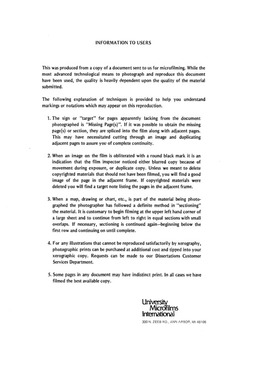| dc.contributor.author | Vartabedian, Laurel Cauthers Klinger, | en_US |
| dc.date.accessioned | 2013-08-16T12:28:25Z | |
| dc.date.available | 2013-08-16T12:28:25Z | |
| dc.date.issued | 1981 | en_US |
| dc.identifier.uri | https://hdl.handle.net/11244/4907 | |
| dc.description.abstract | The simplest and most economical analysis was by Chi square. The Chi square statistic presented opportunities to assess significance for each cell separately, as well as, for columns, rows, and for the entire table. Only the age 75-79 year old cohort demonstrated a significant relationship between age difference of spouse and longevity. Men with wives one interval younger (age 70-74) lived longer than would be expected when compared to the percentage of men married to women in that age category. Also, men married to women who were one interval older (age 80 or older) died in far greater numbers than would be expected based on the living population. Thus, there was limited support for the hypothesis. In the discussion it was noted that more typical role relationships resulted in lower rates of mortality in the 75-79 year old cohort. However, findings overall were not conclusive enough to be generalizable to other age cohorts. | en_US |
| dc.description.abstract | Heuristic conclusions were offered based on the general findings of this study. Future research which would further examine communication related factors in the significant cohort was recommended as an outgrowth of this study. | en_US |
| dc.description.abstract | The data for this study were derived from two national sources. The proportion of deceased persons was calculated by using relevant information from the National Mortality Followback Survey (National Center for Health Statistics, 1968). The data for the proportion of living persons for each age category were drawn from the 1970 Census of Population, Subject Reports, Marital Status (Bureau of the Census, 1970). Both samples were narrowed to include only married, white males, between 50-79 years of age married to women from 10 years older to 25 years younger. Ages of married males and ages of their spouses were divided into five year intervals. | en_US |
| dc.description.abstract | This study was designed to determine whether there were any significant findings related to age difference in marriage and longevity. This general approach assessed the usefulness of the topic area for further study and identified specific areas deserving more detailed research. Neither the necessary data nor the research foundation was available to devise a study which could test for interpersonal and intrapersonal effects in marriage on longevity. However, there was some tangential support for the supposition that age-related role relationships do exert a powerful influence on both marriage and longevity. | en_US |
| dc.description.abstract | The purpose of this investigation was to examine the influence of age difference in marriage on longevity. While acknowledging the central importance of genetic and physical factors in predicting longevity, recent research has also stressed the profound effect of social influences. Although communication factors have not been explored directly in longevity study, such factors are implicit in the interactive nature of relationships. This study explores age differences in marriage as one of the social factors which may influence the dynamics of marriage, and therefore, longevity. | en_US |
| dc.format.extent | iv, 79 leaves ; | en_US |
| dc.subject | Speech Communication. | en_US |
| dc.title | The influence of age difference in marriage on longevity. | en_US |
| dc.type | Thesis | en_US |
| dc.thesis.degree | Ph.D. | en_US |
| dc.thesis.degreeDiscipline | Department of Communication | en_US |
| dc.note | Source: Dissertation Abstracts International, Volume: 42-07, Section: A, page: 2934. | en_US |
| ou.identifier | (UMI)AAI8129423 | en_US |
| ou.group | College of Arts and Sciences::Department of Communication | |
